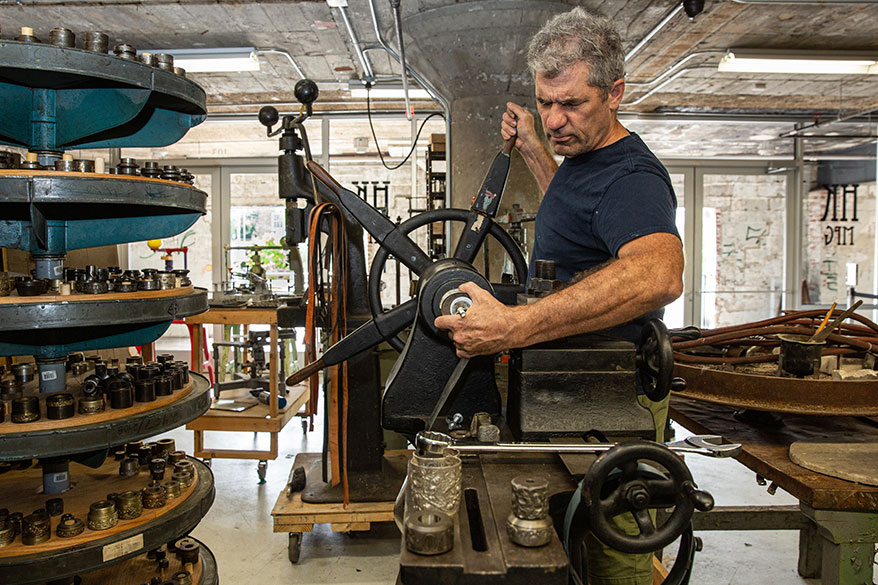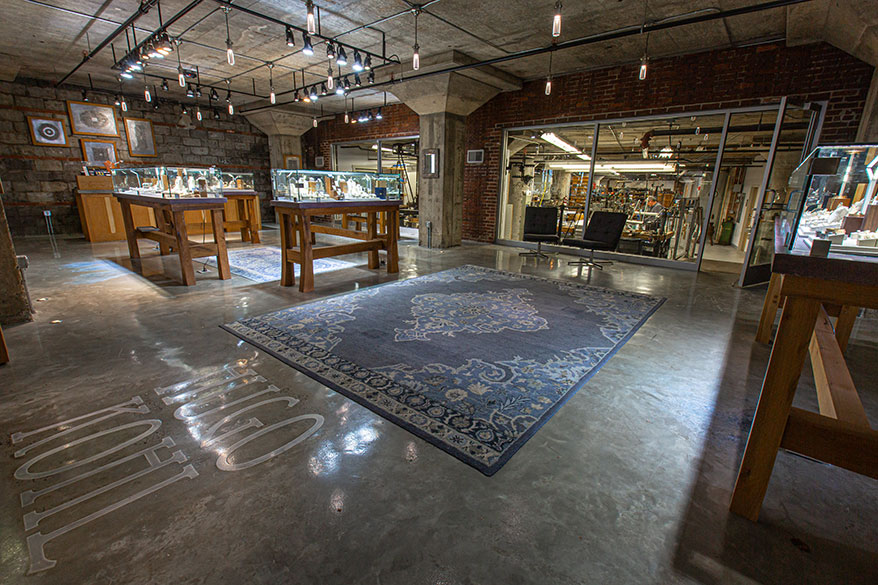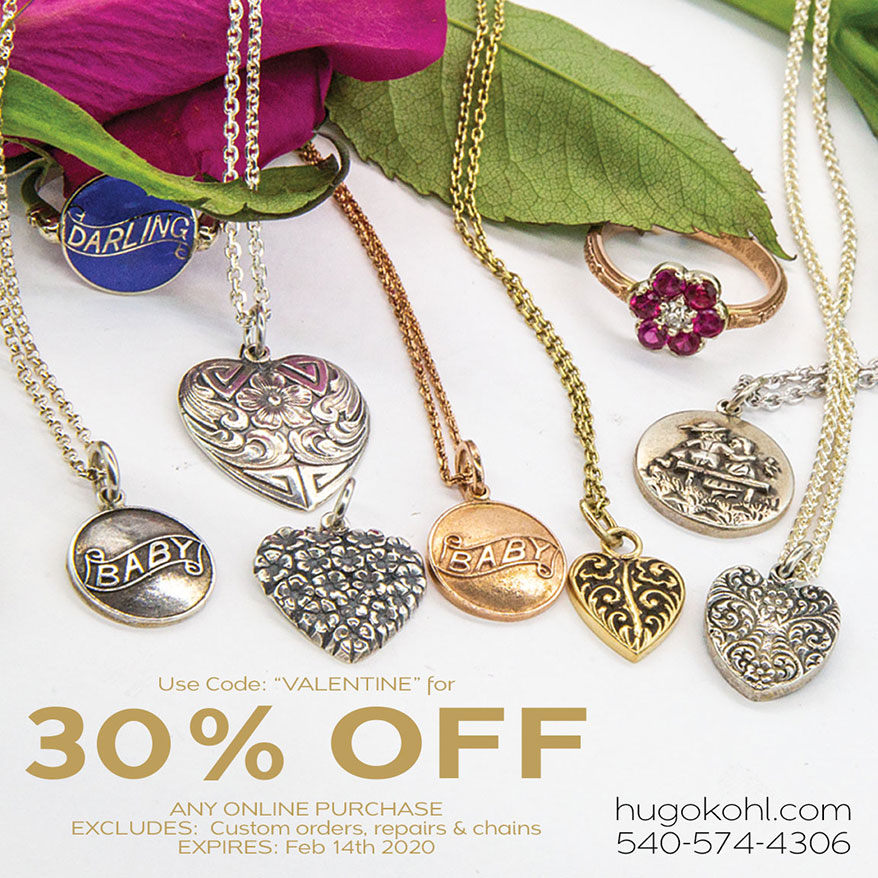SMALL COOL 1ST PLACE: Hugo Kohl Jewelry, Harrisonburg, VA
Hugo Kohl Jewelry, Harrisonburg, VA
OWNER: Hugo Kohl; URL: hugokohl.com; FOUNDED: 1991; OPENED FEATURED LOCATION: 2015; SHOWROOM: 2,000 square feet; total 7,800 square feet; EMPLOYEES: 5; ONLINE PRESENCE: 1,347 Instagram followers; 937 Facebook followers; 170 5-Star Google reviews
It took a car chase and a stack of cash to set Hugo Kohl’s career path in motion.
At the time, Kohl, a goldsmith, owned a jewelry trade shop in Harrisonburg, VA. In 1993, lured by a Washington Post travel story, he and his family decided to vacation in Providence, RI. “I knew Providence had some importance with jewelry; I just didn’t know how much at the time,” he says. Intrigued by a listing for the Providence Jewelry District on a tourist map, he decided to check it out, but when he got there, he found only ruins of warehouses and closed factories.
After consulting a phone book, he found a factory that sold jewelry manufacturing equipment and decided to stop by. While there, he saw workers throwing pieces of metal into a truck destined for the scrapyard. When they picked up an antique looking yellow cabinet, it fell apart and an avalanche of rusty metal trinkets spewed forth. Curious, he picked a couple up and discovered they were intricately carved tiny sculptures. As the truck pulled away with the contents of that cabinet, Kohl panicked, because although he didn’t know exactly what he had found, it looked to be more treasure than trash.

Hugo Kohl is most at home in a studio and employs a variety of vintage and antique tools in his work.
“I hopped in the car, caught up with the driver, and started to drive alongside the truck, beeping my horn, yelling at this guy, while cars were zooming by!” Kohl recounts.
The driver, assuming something was wrong with his vehicle, pulled over. Kohl hopped out and, after fishing his family’s vacation money out of his pocket, laid 10 $100 bills on the hood of his car, placing one bill on top of the next so the driver could see how much he had. Then, in a dramatic gesture, he grabbed the stack of cash and ripped the bills in half, giving the driver one half and telling him, “If you let me get something from the back of the truck, I’ll give you the other half.”
Advertisement
The driver agreed, and Kohl, after some time spent digging in the truck bed, walked away with the contents of that old cabinet. “While I didn’t have a true understanding of what I was looking at, I knew it contained important jewelry designs in the form of deep relief engravings done in tool steel,” he says. “From this serendipitous opportunity, I ended up with a few hundred mini-Michelangelos. Once I found this first box of hubs, I became obsessed with finding as many of them as I could possibly find.”
These hubs (or molds) were the kind used to make die-struck jewelry in Providence, a jewelry-manufacturing center from the 1790s until the 1940s, when casting began to take over the trade. A hub is a 3D rendering of what the finished jewelry is going to be, but it’s executed in tool steel. Die-struck pieces of jewelry are made by mechanically hammering and pressing a thin sheet of gold or other metal onto a hardened steel die to make a pattern or impression.
“What I stumbled into was the very end of this industry coming undone,” Kohl says. “If I had been there a year later, nothing would have been there.” Because the die-struck process was eventually replaced by casting and manufacturing jobs moved out of the U.S., the jewelry factories in Providence began to close in the mid-1970s, their contents left for the scrap heap.
It took years to research his initial haul of 300 hubs, and then he began searching for the antique and vintage equipment he needed to re-create jewelry from those hubs and learn how to use it. That first find in Providence was just the beginning. Now he has master models for filigree and signet rings, pins, pendants, earrings, bracelets, watch cases, cufflinks, lockets, religious medallions and wedding bands.
“What started as a few hundred pieces has grown into over 7,000 hubs, dies and rolls that we use to manufacture collections from,” he says. “It also led to gathering the tools, machinery and workstations needed to process these designs. One of my missions is to preserve the skills that come with these machines.”
Advertisement
Kohl had grown up on military bases around the U.S. and Europe, traveling the world with his parents, who worked for the federal government. “I’m from planet Earth,” he says. But his mother was a serious and well-regarded studio artist as well, and to this day, a studio is where Kohl feels most at home. After serving in the U.S. Marines, Kohl started college at age 26. His degree is in finance and economics, but he also started taking metals and jewelry classes primarily as a strategy to boost his GPA while he struggled through accounting. “When introduced to jewelry specifically it wasn’t ‘Oh, wow, this is what I want to do!’“ he says. But not long after earning a college degree, he abruptly switched gears, got a job on the bench and apprenticed with a goldsmith. “I think of myself as a maker. I like to make things. Jewelry just happens to be the medium that I ended up in.”
By the time of his Providence discovery, he owned the trade shop in Harrisonburg that he had opened in 1991, servicing about 20 stores in his area.
In 2015, when he opened his combination manufacturing and retail location in a revitalized icehouse in downtown Harrisonburg, he wanted to make sure visitors could see the jewelry being made. He designed a pathway through the workshop among the machinery and tools. Humans, he says, are built to make things, and so it’s natural for visitors to be attracted to the process. “It’s amazing the effect that has on certain people,” Kohl says. “It’s almost like you made it yourself. You want to own it. So it has an effect on the register. It helps drive sales.”

Floor to ceiling windows showcase his anachronistic machines, the largest collection of vintage machinery still in operation, he says. The collection includes a late-19th century 9-foot tall drop hammer, a 1940s machine that lays out gemstone patterns, and shelves full of dyes, rolls and thousands of hubs. “The jewelry industry and Industrial Revolution start in the same place,” he says. “They were innovating constantly. One of the things they were doing all the time was as new materials and processes came online, they were adopting them as quick as anyone was.”
In turn, Kohl respects the past but isn’t stuck there. “Some things I make only as they made them, because it’s the best way. And sometimes I take advantage of newer technologies. I’m not limited by the same processes. I have machines in here that when they were built, they were gravity powered or human powered but may have been refitted with older electric motors.”
He began his venture by making a small collection of die-struck jewelry he sold to wholesale accounts, and now Kohl has a vertically owned retail, wholesale and manufacturing company. “I own everything but the mine,” he says.
“Raw materials come in one door and go out a couple of different doors.”

Hugo Kohl’s marketing and social media is done in-house with an emphasis on artistic photography.
Kohl specializes in making and selling 20th century jewelry designs from the Art Deco period. Almost everything he makes is available in a wide variety of metals, including sterling silver, 14K, 18K gold in yellow, rose and green, as well as platinum and palladium. ”What I try to put out there are things that I understand to be beautiful, meaning that all humans find certain kinds of attributes to be beautiful,” Kohl says. “It has to be beautiful in the objective sense, and it has to be tough and durable. I like to make things that I can sell to you and you can pass on to someone else.”
Not only is the jewelry objectively beautiful, but the showroom is as well, built to the classic design proportions of the golden mean. “The room in its length and width and height has that proportion. Even when completely empty, it’s visually very pleasing. It feels like a room should feel. It is not oblong. There are no empty spaces. When I put a tape measure to it, I said, ‘Wow, it really is a perfect room.’”
Advertisement
The boutique is about 3 feet higher than the factory floor, which is separated by two sheets of glass and framed by six concrete columns. The walls are decorated with original Impressionist paintings, large engravings and original brickwork. The jewelry cases are native white oak.
Kohl’s work is the perfect happy accident of discovering something he loves that enables him to make a living.
“I love making beautiful things,” he says. “I would pay to do this. There’s nothing else I could do besides this that would give me more satisfaction. I’m surrounded by thousands and thousands of beautiful pieces of artwork.”
Still, since he’s got to make a living, he also appreciates the competitive edge his venture offers. “This is it, there is no more of this,” he says, surrounded by hubs. “Nobody can go head to head against me in this genre.”
JUDGES’ COMMENTS
- JACQUELINE CASSAWAY: Hugo Kohl offers the bench jeweler experience, authentic handcrafted jewelry and an artisan feel.
- KATHERINE COTTERILL: I love the contrast between the industrial feel of the workspace and the elegance of the showroom. Hugo has really created something special by salvaging part of our history!
- MEGAN CRABTREE: The videos produced showcasing the factory, tools, and even specific work stations like the adjustable buckle bracelet station were incredible! Opening this to the public by having daily tours creates a one-of-a-kind experience and educates the customers on what it takes to make these amazing pieces of art.
- LARRY JOHNSON: The architecture of the building and the design of the interior all combine to produce a unique experience to the customer that will not easily be forgotten.
- PAM LEVINE: The Hugo Kohl brand redefines cool through a dedication to preserving the legacy of jewelry making, craftsmanship, history and period design. A combined museum, workshop, gallery and store invites visitors into a completely immersive experience. Utilizing new age technology such as video and social media, the brand is accessible, current and very cool.
- ALP SAGNAK: This one is a museum! I watched the video on the website from start to finish, and I wished I were him. Perfect!
PHOTO GALLERY (22 IMAGES)
Five Cool Things About Hugo Kohl Jewelry
1 QUALITY OF LIFE. Kohl looks for workers who are keenly interested in the jewelry-making process, respects their work-life balance and strives to make them comfortable. “Working alongside people who like their jobs and are interested and curious about their work is invigorating,” Kohl says. “In order to get the very best work from staff, they need to be relaxed and not under constant stress. They need ergonomic work stations in well-lit spaces with the best tools to do their work. Creative workers flourish when given control of the making process and allowed a voice in how we work.”
2 DIGITAL PRESENCE. “I think our website is beautiful,” Kohl says. “It has a good click-through rate, and the images accurately reflect the pieces we make. Our digital presence away from our website is also broad and deep. Folks looking for objective points of view can find a long list of media about Hugo Kohl with a simple search. It’s becoming clearer every day that besides jewelry design and manufacturing, we must also be a digital, social media production company.”
3 INDUSTRY CRED. Kohl connected with Peter DiCristofaro of the Providence Jewelry Museum, who helped him curate his collection and develop a buying strategy after DiCristofaro realized Kohl was serious about preserving the traditions of Providence. Kohl is now a board member of the Providence Jewelry Museum and founded the Museum of American Jewelry Design and Manufacturing. This year, Kohl had been scheduled to present “Reviving the Industrial Age manufacturing art, design & technology of mid 1920s to mid 1930s filigree jewelry of Providence, RI” at the Santa Fe Symposium, before it was postponed due to COVID-19.
4 DOWNTOWN LOCATION. Hugo Kohl Jewelry has found its home in the historic CASCO Icehouse complex in downtown Harrisonburg, VA. It is a revitalized industrial space with several restaurants and a brewery. Kohl has been involved in the downtown revitalization for more than 30 years. “Our boutique and factory have become an anchor location,” Kohl says.
5 BALANCING RETAIL AND WHOLESALE. “I think we have worked out a great way to adapt to changing markets by operating in both retail and wholesale worlds,” Kohl says. “Our boutique allows us to serve our community. Our retail website allows us to expand our community to potentially unlimited people. Our wholesale website and catalogs allow us to serve an entirely different customer base. This allows us to diversify our income streams.” While he has dedicated websites for retail and wholesale, he offers more selection to wholesale clients.
TRY THIS: Recognize the importance of allowing clients to watch bench jewelers at work, whether or not they are working on 19th century machines. Offer tours of the shop or a window into the mysterious world of goldsmiths and engravers. Hugo Kohl has found that seeing the process leads to more interest in the product and more sales.